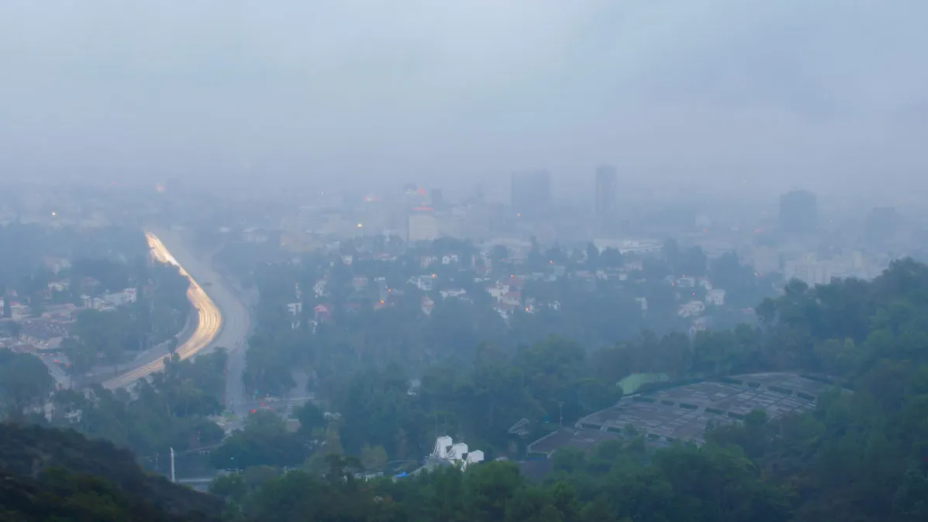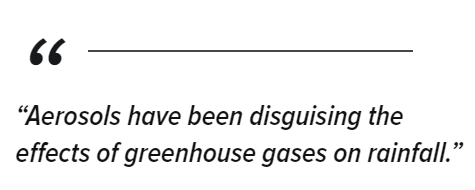A study suggests that high levels of aerosol pollution have offset higher precipitation levels caused by a warming climate.

As greenhouse gas emissions raise the temperature of the atmosphere, scientists expect global rainfall to increase, but making regional precipitation predictions is challenging. And it’s at the regional level that these predictions are most important for many. Farmers and water managers need to make plans and adjust to climate change.
“Especially for rainfall, what’s happening locally is really important,” said Mark Risser, a climate scientist at Lawrence Berkeley National Laboratory. Risser is an author of a recent study published in Nature Communications that aimed to clarify rainfall trends in the United States by incorporating data about aerosol air pollution. Aerosols are small floating particles that have a drying effect on global climate. Some sources of aerosols are natural, such as sea spray and volatile organic compounds released by plants. There are also anthropogenic sources, such as emissions from the burning of fossil fuels.

The research suggested that climate-change-driven rainfall increases in the United States have been offset by historically high levels of aerosol pollution. But because aerosol levels have fallen in recent decades, thanks to passage of the Clean Air Act in 1970, we are beginning to see more heavy rainfall. Factoring this pollution into climate models can make regional trends clearer, Risser said.
“The implication is that aerosols have been disguising the effects of greenhouse gases on rainfall,” he said. “We unmasked changes happening behind the scenes.”
Small Particles, Big Influence
Precipitation levels vary highly from year to year. It’s extremely challenging to separate the slow changes wrought by global warming from these yearly trends, said Jesse Norris, who studies precipitation at the University of California, Los Angeles Center for Climate Science. Norris was not involved with the study.
As concentrations of greenhouse gases in the atmosphere increase, Earth gets hotter. Warmer air can hold more water vapor, and warmer oceans are more prone to evaporation. This should result in more rain, said Risser. For every degree Celsius the average temperature rises, there should be a 7% increase in global average precipitation, but this trend doesn’t always appear in regional precipitation data. “When zooming in on the U.S., this wasn’t showing up in the data,” Risser said.
Risser said the complex effects of aerosols have made it more challenging to clearly see how climate change is influencing precipitation. The aerosols examined in the study offset the effect of greenhouse gases by reflecting solar energy back out into space and cooling the planet. But these aerosols can also have localized impacts on precipitation. That’s because aerosols can influence what kinds of clouds form and how water droplets form within those clouds, said Risser. So depending on the season and local conditions, aerosols can also drive the formation of severe storms, as was in the case of Hurricane Harvey.
Sinking Sulfur Dioxide Levels and Rising Rain Rates
Aerosol emissions were increasing for most of the 20th century until the passage of the Clean Air Act, which regulated pollutants including sulfur dioxide (SO2). The main source of SO2 is industrial burning of fossil fuels, particularly at power plants. SO2 emissions contribute to acid rain, and inhaling SO2 can cause respiratory problems, particularly for people with asthma. This kind of air pollution can also drive the formation of another form of pollution called particulate matter, which can also cause respiratory problems, as well as cardiovascular disease and pregnancy complications.
After 1970, SO2 aerosol emissions in the United States fell gradually but in the past 20 years have gone back to preindustrial levels, said Risser. Norris said it has taken some time for the climate impacts of this to emerge in data because aerosols can persist in the atmosphere for years. “The impact of those aerosols not being emitted is becoming clear now,” Norris said.
Risser and his team used 120-year rainfall records to study both extreme and average rainfall trends. They separated these trends by regions and by seasons and combined these data with emissions estimates of both greenhouse gases and SO2, one of the best-studied aerosols.
After accounting for SO2 aerosol and greenhouse gas emissions, Risser said, global rainfall trends become more evident. Increasing greenhouse gas levels cause increased average and extreme rainfall across all seasons in the United States.
The study also looked at seasonal emissions and precipitation trends, dividing the country into 25-kilometer boxes. In winter and spring, the study found, higher local aerosol emissions lead to drier conditions. In summer and fall, the opposite is true. These seasonal trends are clearest in the northeastern and southeastern United States and in the Great Plains. For the western United States, Risser said, the study is less conclusive. “There’s a lot more year-to-year variation in rainfall in the western U.S., which makes it harder to attribute changes to greenhouse gases or aerosols,” he said.
Norris called the aerosol study “an important step in helping to understand why we struggle to see long-term precipitation trends.”
Cornell University Earth and atmospheric scientist Natalie Mahowald is more skeptical. She noted that aerosol sources and distributions prior to 1980 are not well known. She said this “injects substantial uncertainty” into the rainfall study. And she pointed out that there are many other kinds of aerosols, including nitrogen oxides, black carbon, and those found in wildfire smoke. Adding these into the study could change the results.
Article Credit: eos